Touring Lithuanian Cities

|
A trip that begins in Vilnius with its many churches, the 'Republic' of Uzupis and excursions to sculpture park Europos Parkas and Trakai, a town with a castle on an island in a lake; on to Kaunas, a university city with a Devils Museum and many beautiful historic buildings. An excursion by bike from Siauliai to Crucifix Hill with its thousands of crosses; by train to the hamlet of Silenai. Back in Vilnius a visit to the depressing KGB Museum.
Travelogue & photos: Marianne Komen
Vilnius
City of a hundred churches
My first introduction to Lithuania is a taxi driver with a death wish, who takes me from Vilnius Airport to my hotel. Half-way the driver all of a sudden veers off the road and turns at full speed onto a narrow sandpath riddled with potholes to avoid a traffic jam.
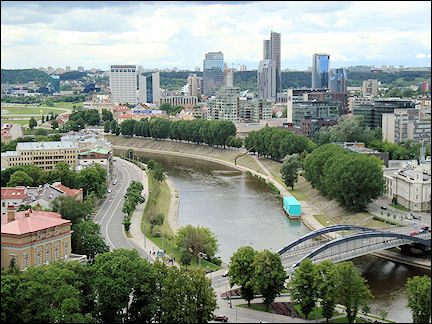
|
Rocking and bumping, while the driver swerves from left to right to avoid the potholes, I sit in the back with a frightened expression, holding on to the door. Oncoming traffic only makes me more scared, but fortunately the ordeal doesn't last very long and soon we are back on the regular road.
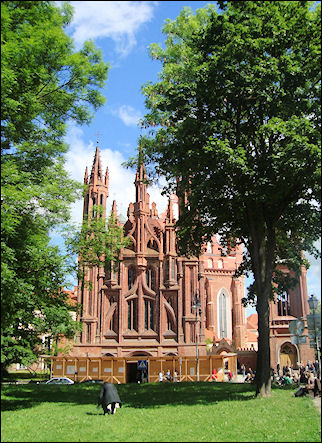
|
After installing myself in my hotel room, I go out to explore Vilnius, armed with a city map. The old city center is large and has countless churches, most of them Catholic and some Orthodox. Vilnius is sometimes called "city of a hundred churches". During the Soviet regime many churches were used for storage, as sports centers or atheist museums, even though I don't know what the latter would look like.
I visit many churches, one even prettier than the other, but also one that still has to be restored. Hidden behind an 18th century gate is the Holy Trinity church from 1514. Inside ugly green school benches and other stuff are stored. The chapel to the right looks restored, though and seems to be in use.
The St. Anna and the Bernardine churches, both in late-Gothic style (16th century), stand so close that they look glued together.

|
The Saint Anna church is remarkable for its 33 different kinds of brick that were used in building it. It is said that Napoleon would have wanted to carry it in the palm of his hand to Paris.
Tourists are not the only visitors of the churches, believers walk in and out to pray. On Sundays the Orthodox church of the Holy Spirit is filled to capacity. At the entrance are tables arranged in a U-shape, covered with plastic bags, many of which contain fruit. This church from 1638 was reconstructed in 1750 in Rococo style. It has a wall with beautiful icons.
The Gate of Dawn (Ausros Vartai) from the sixteenth century is one of five original gates in the stone walls around the city. Over the gate is a chapel and when I pass, I hear singing.

|
I go up and listen to the choir for a while; they sing beautiful songs. Meanwhile I take a look at the chapel with a wonderful madonna covered with leaf-gold.
A group of artists declared an independent republic in 1997, in the old district Uzupis; it has its own national anthem, constitution, bishop and president. And no less than 4 national flags: one for each season.
One of the first acts of the Republic of Uzupis was erecting a statue of their patron saint Frank Zappa, on a spot outside the district where a statue of Lenin used to be. The statue was unveiled by the then Czech president Vaclav Havel, while a military brass band played Zappa songs.
The Dalai Lama was appointed ambassador during his visit here. The national holiday is, of course, April 1. An angel on a high pedestal is the symbol of the republic.
A few rules from Uzupis' constitution: Everyone has the right to make mistakes; everyone has the right not to understand anything; a dog has the right to be a dog.
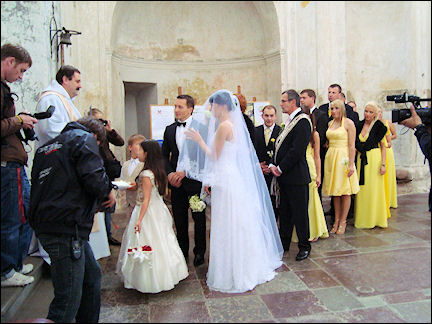
|
On Saturday I frequently see bridal couples with their parties near churches and in the streets. During the summer, Saturdays are popular for weddings. Sometimes I even see a bridal procession waiting for their turn inside a church. Outside the church is a kind of reception going on: cheerfully chatting people with glasses of liquor.

|
To confirm their commitment to each other, after the ceremony couples hang padlocks on the iron balustrades of a bridge over the Neris river an throw the key in the water.

|
The city center of Vilnius has stores with expensive brand clothing, restaurants, outdoor cafés and lots of shops that sell amber souvenirs. It's incredible how many things are made of amber: bracelets, necklaces, rings, key chains, chess games, animal figures. I visit the amber museum which has a collection of amber with insects, other small animals and plants in them.
I take a funicular up to the remains of the Gediminas castle. In its octogonal tower is a small exhibition about the history of the Fortress Mount on which the castle sits. From this altitude I have a great view of the city.
One evening I still have enough energy left to take a walk outside the old city.
I cross the Green Bridge (1952), which is decorated in socialist- realist style, over the Neris river to the modern part of Vilnius which has a surprisingly beautiful hyper-modern mall.
Europos Parkas
A park with works of art from 33 countries
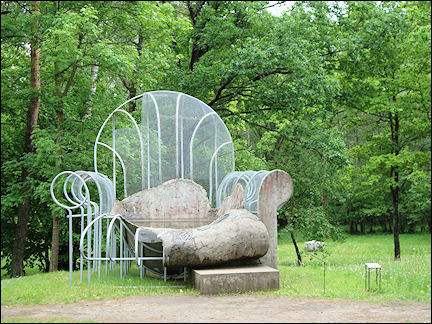
|
French scientists calculated in 1989 that the center of Europe is 26 kilometers north of Vilnius. The sculpturist Gintaras Karosas seized the opportunity to decorate the woods there with art. Meanwhile it has evolved into the open-air museum Europos Parkas, which displays over a hundred workds of art from 33 countries.

|
I am the only visitor in this wonderful park with lots of birches. The art is beautiful, interesting, sometimes funny and somehow fits the natural surroundings of the park. The most famous pieces are a large chair by Dennis Oppenheim and an installation of 3,000 televisions, organized into a maze, behind a demolished Lenin memorial.

|
I take a bus from Vilnius to visit Trakai, in the past the capital of Lithuania and now known for its castle on an island in one of the many lakes around the city. A grand prince invited a group of Karaites (a Jewish sect) from the Crimea at the end of the 14th century. They were employed as bodyguards for the prince. Between 150 and 200 descendants of them still live in the area.
Their wooden houses are recognizable by three windows on the side of the street. Trakai has a Karaite sanctuary and museum. I visit the synagogue, but unfortunately the museum is closed.

The sight of the castle in the water is breathtaking. After going through the gate, you arrive at a large courtyard. The castle houses a national museum with an interesting collection of pipes, china miniatures and an exquisitely furnished bedroom with embroidery at the foot of the bed.

|
The rest of the castle has columnades, stairs and huge spaces where nothing in particular draws attention.
A boat on which I am the only passenger shows me every side of the castle from the water. Afterwards I take a hiking trail that is marked on the map of the area. It leads over a rickety bridge on drums along the lake, and then goes to the village of Varnikai.
The landscape is green and rolling. Varnikai is a hamlet with some old and new houses and farms. On a tall pole near a house sits a stork nest with chicks. An old woman walks home. Apart from her, I see nobody.
Kaunas
University city with lots of old buildings and museums

|
It's a two-and-a-half hour ride by bus from Vilnius to Kaunas, where I arrive early in the afternoon in a super-modern hotel with a personal welcome on a large television screen in my room.
Kaunas is the second largest city in Lithuania; in the past it was the seat of the government and of bishops. Even before the German army took the city in 1941, Lithuanian fascists already killed many Jews. The SS competed the job and murdered the remaining Jews.
Today Kaunas is an important university city and has - apart from historical buildings - many museums. The city center is much smaller than that in Vilnius and I see a lot of it on my first afternoon.
Laisvès Alèja (Freedom Avenue) is a wonderful shopping street with a footpath lined with two rows of trees in the middle. It is a pedestrian street, which is nice for walking. Most shops in the street are fashion stores and it looks as if the financial crisis has made victims here as well: lots of empty storefronts.

|
Laisvès Alèja leads to an underpass below a highway and at the other side the old city center is visible. I arrive on a square with the old City Hall, which is now in use as a wedding chapel. Behind this building is the postal museum, which I skip, except for the stage coach outside. To the left of the city hall another beautiful church.
At the other end of the square I arrive at an old building that doesn't look like it's open to the public. According to some girls who are drawing the building, it is a monastery. In the park next to it stands a nicely carved wooden cross.

|
Wandering around I arrive at the remains of a castle. It is currently being restored and therefore not open to the public. There isn't much to see anyway: a tower and an arcade. The castle is located in a large park and the weather is nice, so I take a walk. At the end of the park is the spot where the Nemuno and Neris rivers merge.
Back in the old center I visit the Gregory church, which is in a bad state of repair both inside and out. A monk there tells me that it will cost 15 million euros to restore the building to its former glory.

|
I take the Aleksotas Funicular (1935) to the top of the hill to see the view from there, but there isn't much to be seen. It's just a higher lying part of the city. But there is another church, all white and with a remarkable architecture; it was used as a sports center during the Soviet era.
I return to the city center and visit the Orthodox cathedral and some museums. First the museum in honor of the composer and painter Ciurlionis (1875-1911), who is famous in Lithuania. The paintings have mystical and symbolical meanings. They disappoint me in terms of color, even though there are a few nice ones. Because he also was a composer, some paintings have the word "symphony" in their titles. I listen to his music in an auditorium; an old man plays the CD I want to hear and I sit there by myself, enjoying the piano music.

|
The Devils Museum has an out of control collection of devil sculptures belonging to the artist Zmuidzinavicius. It has three floors, so it houses a lot of devils. The sculptures and figurines - large and small - are made of wood, china, clay and other materials. The most remarkable one is a wooden Stalin chasing Hitler.
Near both museums, which are near each other, is a memorial for people who died during the Soviet era and in the war. Next to it burns an eternal flame and there are beautifully carved wooden crosses.
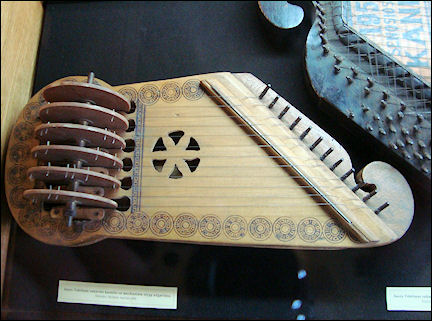
|
Later in the day I visit Povilas Stulga's Museum, which has a collection of folk-musical instruments. It is a nice experience because of the two ladies who accompany me and point out what there is to see. There are many types of flutes, other wooden wind instruments, accordeans and a kanklės, the national musical instrument, which is a kind of zither. There also are many old photos, which is fun, too.
Siauliai
A procession hurries on in the pouring rain

|
A bus takes me in three hours to Siauliai, north of Kaunas. Siauliai is the fourth largest city of Lithuania. The city was heavily damaged in both world wars. The population, half of which was Jewish, was decimated in WWII.
I take a taxi from the bus terminal to the hotel. It turns out I booked an old hotel and my room's furnishing is old-fashioned. But everything I need is there and it's clean.

|
Siauliai has a small city center with a long pedestrian shopping street, which displays small works of art: birds over a bronze nest, a dog with glasses in front of a optician, iron cats on a roof. Fun ideas.
The city doesn't have a lot of attractions, except for its Peter and Paul church: a Renaissance building surrounded by many carved wooden crosses.

|
The next day it rains dogs and cats. Armed with an umbrella I look for a place to have coffee. While I'm sitting there, a procession approaches. Curious as I am, I quickly pay and follow the crowd. Only back home I find out what the occasion was for the procession: Sacrament Day.
The procession is predeced by ladies in traditional dresses, followed by bride's maids who strew rose petals in front of the priests, guided by nuns. All carry large umbrellas and are covered with transparant plastic. A small women's choir walks behind the priest and then the crowd of believers. It looks as if there are more umbrellas than people.

|
The procession stops in the middle of the shopping street. The priest says some prayers at a table and then everyone continues walking. This scene is repeated at the end of the shopping street and then the procession hurries on to the church. Something is going on outside the church, but I go inside where a service is being held. After it is finished, the procession enters and after a few words at the altar it's over. Everyone hurries outside, back into the rain.
In the afternoon I walk in a part of the city with desolate looking apartment buildings from the Soviet era; a bit of paint would do miracles here. I arrive in a park with a 21 meters high sun dial with a shining, gold-colored archer on top. The park is bordered by Lake Talksa on one side and a cemetary on the other.
I walk around the cemetary and despite the rain it's a nice walk. I stop at a highway where I can see the entrance of the cemetary, which has a pretty gate.
Crucifix Hill
Strings of crosses fan out from the hill

|
The next day I rent a bike at the Tourist Office. I want to visit Crucifix Hill by bike, a distance of only 12 kilometers. I select the least bad bike from four and leave.
The beginning of the foot- and bikepath has lots of potholes and rifts, so I have to walk quite a long distance. The bike isn't too good, so it takes me an hour of heavy, hard pedaling, most of the time on a rolling bikepath.
Crucifix Hill originated in the 15th century. There was a sanctuary on the hill and a chapel was built. Pilgrims brought crosses and left them on the hill. Later people began to leave crosses for those who were expelled to Siberia and couldn't be remembered publicly.
In their attempt to create an atheist society the Russians bulldozered the slopes twice. In 1990 thousands of people climbed the hill, carrying crosses and ever since then the situation got out of hand: people from all countries leave crosses here, large, small, simple or sometimes beautifully decorated.

|
Lot of small crosses and rosaries hang from the large ones. At the top of the hill is a Maria statue, which is out of place here, I think.
There is no room left on the hill and strings of crosses fan out in different directions from the hill. The spot has a quiet atmosphere and is surrounded by a green plain, which contributes to the atmophere.

|
There are market stalls in the parking lot where you can buy crosses in all sizes, kinds and prices. Buses usually bring crowds of tourists here, but fortunately it's quiet now. Still impressed, I ride back to Siauliai. Half-way I have a drink in a restaurant.
Silenai
The road through the green landscape seems endless

|
On my last day in Siauliai I decide that I want to take a train trip and ask the receptionist about the train schedule to a nearby village. The train moves at walking pace through the landscape, you could keep up with it on a racing bike.
Eventually I arrive in Silenai, which turns out to be really small. It has one long street and behind it a few apartment buildings. I want to go for a hike, so I walk out of the village and take a road. At a railway crossing I have to wait until a long freight train has passed; its wagons look very rusty.

|
I don't like this road, there is too much traffic. I turn back and take a sandpath. Soon I pass the last farm, where people outside look at me in amazement. It's nice and quiet in this green landscape; there are beautiful clouds in the sky and lots of birds. The road seems endless and because I don't know where and how it ends, I walk back.

|
Because it's still too early for the train, I take a walk in the village the other way, but soon I find myself in a dead-end street. A large concrete barrier closes off the village. There probably is an airport behind it: every now and then I see a plane fly over at low altitude.
I find it remarkable that on one side of the road there are new brick houses, on the other side old wooden ones. Old mailboxes are scattered along the road. I suspect they are no longer in use.

|
I meet and old man who is curious what I am doing on the large rock on which I am resting for a while. I tell him cheerfully that it's my birthday and also nice weather. Unfortunately he doesn't understand a word I say, so he shrugs and walks home, his dog in tow.
The ticket window in the train station is boarded up. I ask a woman who is working there on which platform the train arrives. On the train I buy a ticket from the conductor and soon we arrive in Siauliai. In the bus station I ask what time the bus for Vilnius leaves tomorrow.
Vilnius
Small cells with steel beds in the KGB Museum
The express bus needs three hours to get to Vilnius. I actually think the landscape through which we pass again, is a little boring. Lots of green, but also lots of undeveloped land with weeds. Every now and then the bus through a larger village. I frequently see dark woods.

|
This time I approach Vilnius from a different direction and see huge amounts of new apartment building, it feels like a completely different world. I check in in the same hotel as before.
I take the bus to the KGB Museum. It's a big hulk of a building; names of people who died in the war or during the Stalin-regime are inscribed on its walls. Next to the museum is a memorial like the one in Kaunas. By the memorial are large wooden panels with children's drawings.
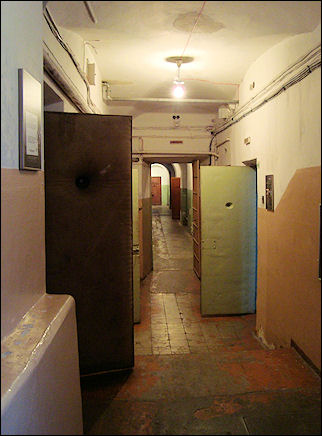
|
The museum has lots of written information and photos, mainly from 1940-1941, when the Russians secretly occupied the Baltic states. Many prominent citizens (administration, politicians) were sent to Siberia, where a horrible fate awaited them. There are also many pictures of partizans who lived in the woods. On the first floor is a room with bugging devices.
It's an unpleasant idea that you couldn't trust anybody in the Soviet era. One could be arrested for the smallest demeanor, especially in Stalin's time. But in later periods the KGB knew how to find people as well.
Visiting the underground cells is depressing. Twenty people lived in a small cell with steel beds. There is a small soundproof room and it doesn't take a whole lot of imagination to undestand what happened there.
The wash room is horrible, especially if you realize that nothing was changed after the prison became defunct. It was in use until 1988, so not even that long ago. I don't visit the execution place, I can't take it anymore. I leave the building in a sad mood and think the times fortunately have changed here.

|
The sun cheers me up a little and when I get to the city center I visit a few stores. And as unbelievable as it sounds, I pass a church I haven't visited yet. The All Saints church is a renovated Baroque building, painted an ugly shade of blue. I shop a little more and on the way I see a pretty sculpture of the three Muses at the drama theater.
On the last morning I take it easy, but still I arrive way too early at the train station. It's fun to watch people in the hall, so I entertain myself anyway. The hypermodern train is ready when I get to the platform. It takes me to the airport in ten minutes.